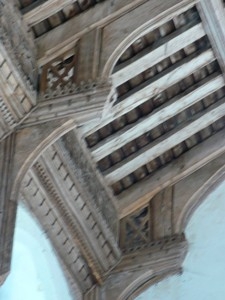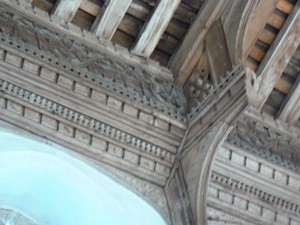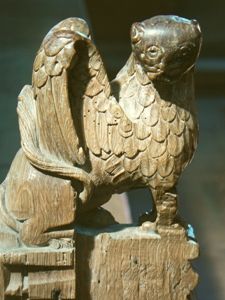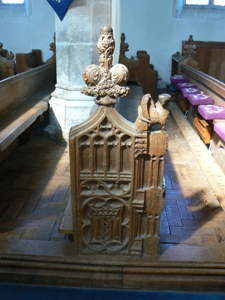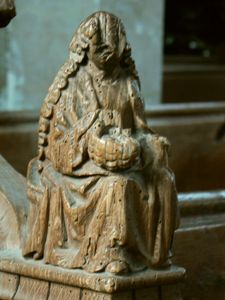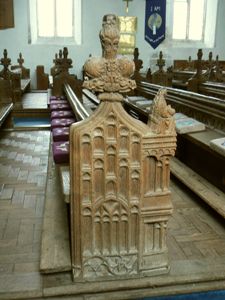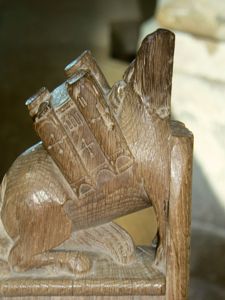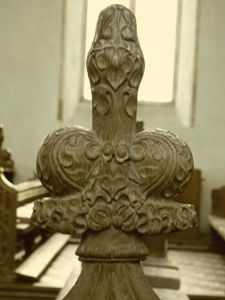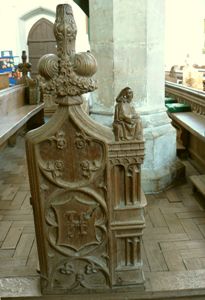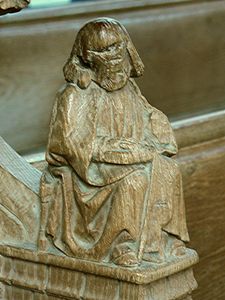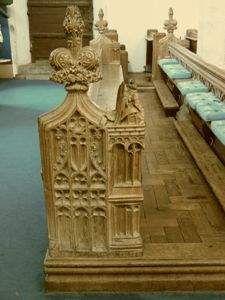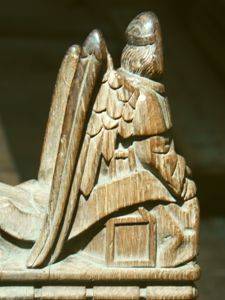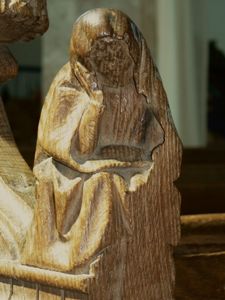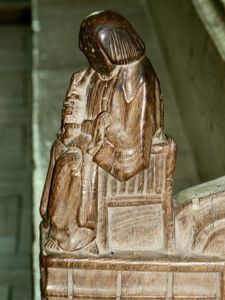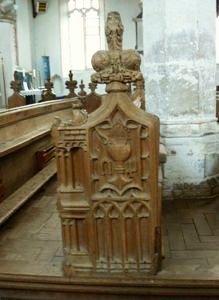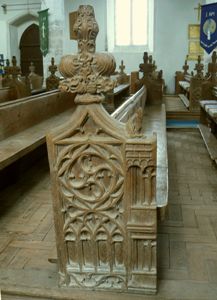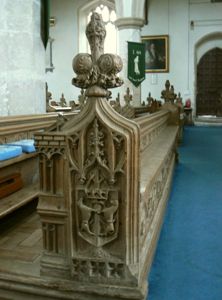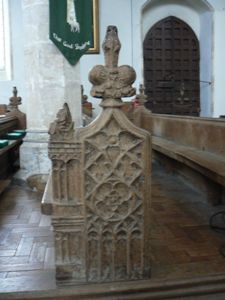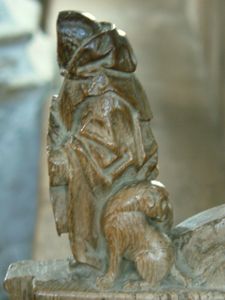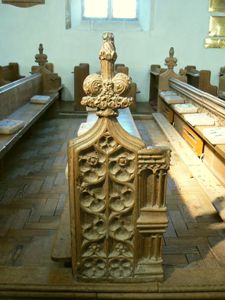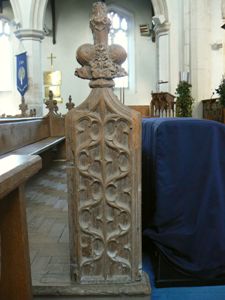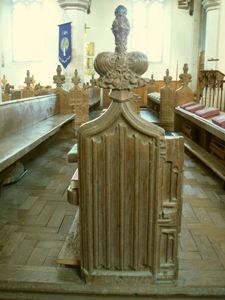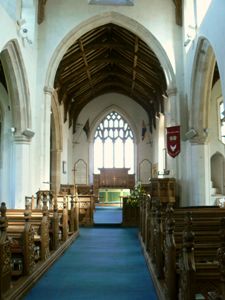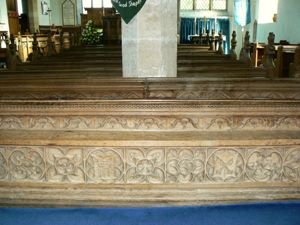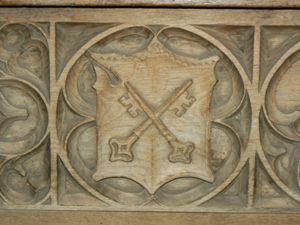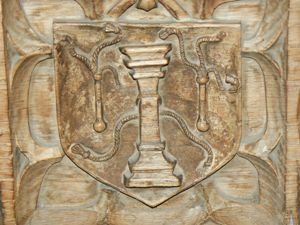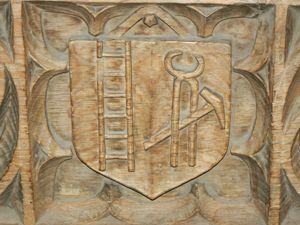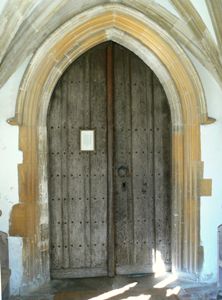
BENCH ENDS
Beautiful carvings of the bench ends in East Anglian churches

|
BENCH ENDS AND GREEN MEN
IN SUFFOLK AND NORFOLK CHURCHES
F LOCATIONS. More will be added as they are discovered.
ST. PETER AND ST. PAUL,
FRESSINGFIELD, SUFFOLK
The church guide says that the village was called Fessefelda in 1086, a name derived from the Old English word Fyrsenfield, meaning a furze-covered field. There is a Fersfield in Norfolk which shares the same derivation.
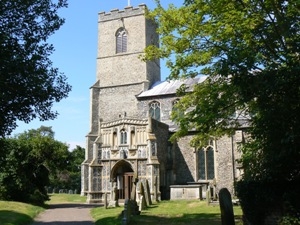 The early 15th century south porch, built by Catherine de la Pole in memory of her husband, who died at Harfleur and her eldest son, who was killed at Agincourt.
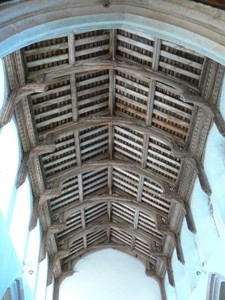
Before moving on to the
late 15th century bench end carvings, just
look at this splendid single hammerbeam roof, also 15th century.
A detail of the finely carved cornice is below. Note the delicate fretwork of vine leaves above it.
Now, to have a look at the carvings down at ground level.
The initials IHC (the name of Jesus Christ), surmounted by a crown, are at the base of the bench end with the carving of a mythological figure, probably a griffin, on the arm-rest - see enlargement at the right.
The arm-rest figure here is St. Dorothy, holding on her lap a basket of fruit or flowers.
This figure, as well as several others in the church, shows great disfigurement. But there seems to be no record in William Dowsing's Journal of his having visited Fressingfield. The damage could have been done in the earlier iconoclasm or by persons unknown acting quite independantly.
Close-up of one of the poppyheads which crown all the bench ends.
The central shield bears the letter H, while it is thought that the arm-rest figure may be of St. Paul.
The angel carved on the arm-rest may be the emblem of St. Matthew.
So far we have seen carvings possibly representing St. Dorothy, St. Paul and St. Matthew. The figure below on the left has no identifying symbols and remains unnamed, but that on the right holding the keys is St. Peter.
The emblem here is of the chalice and host with the initials A. P. These stand for Alicia de la Pole - the poet Geoffrey Chaucer's grand-daughter. Alicia and her third husband, William de la Pole, who was Earl of Suffolk at the time of their marriage in the 1430's, lived for a time at nearby Wingfield. After William's death Alicia extended the Chancel of St. Andrew's Church, Wingfield, where can be seen the tomb of their son John de la Pole.
The top part of the intricate bench end carving at the left is described as a wheel of mouchettes. I am not going to attempt to explain this - I started going round in circles (sorry!) - and can only suggest a dictionary of architectural terms which will do the job admirably. But on the panel to the right is carved a coat of arms, which according to the church guide may be that of the Talbot family. It shows two dogs and a crown.
One more saint on the left and that is a hooded figure with a dog, possibly St. Bernard or St. Roche. The panel on the right displays intricate carving as do the two pictures below. The delicacy of the work on these panels really is a delight to see.
And as a contrast to the detailed carvings of all the panels above, the simplicity of the linenfold below has its own quiet beauty which for me is in no way overshadowed by its predecessors.
A final look down the nave before seeing the carving on the backs of the rear benches.
Most of the benches have an interesting wavy line pattern across the back, just above the shelf, but those at the rear have extra themed carving below as well. The north side is called the Passion bench and the south the Dedication bench. To the left below is a small part of the Dedication bench and to its right a close-up of one of its carvings - the crossed keys of St. Peter.
Below are two close-ups of scenes from the Passion bench. On the left is depicted the pillar, scourges and cords and on the right is the ladder, hammer and pincers.
The interior of the south porch with its vaulted roof. The doors are 15th century.
I am deeply indebted to the writer of the admirable church guide for the identification of the arm-rest carvings above, without which I would have endured much head-scratching to come up with the right description, amateur that I am.
~~~~~~~~~~~~~~~
Click letter for locations with that initial: D G I W Back to Main Bench Ends page
Copyright Ivy Collins 2009
|
The arm-rest mythological figure on the bench end is enlarged at the right.

